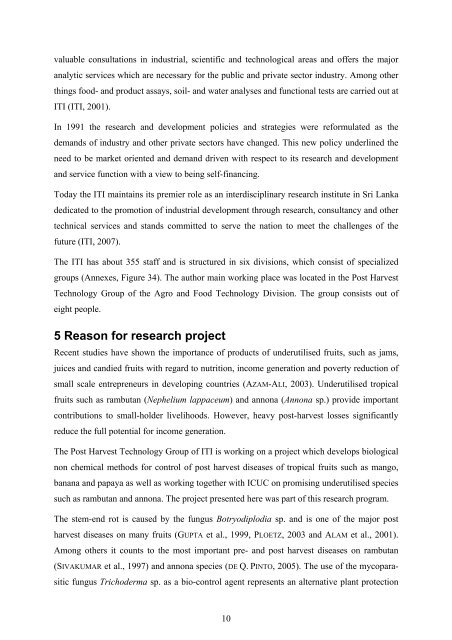Botryodiplodia sp. - Crops for the Future
Botryodiplodia sp. - Crops for the Future
Botryodiplodia sp. - Crops for the Future
You also want an ePaper? Increase the reach of your titles
YUMPU automatically turns print PDFs into web optimized ePapers that Google loves.
valuable consultations in industrial, scientific and technological areas and offers <strong>the</strong> major<br />
analytic services which are necessary <strong>for</strong> <strong>the</strong> public and private sector industry. Among o<strong>the</strong>r<br />
things food- and product assays, soil- and water analyses and functional tests are carried out at<br />
ITI (ITI, 2001).<br />
In 1991 <strong>the</strong> research and development policies and strategies were re<strong>for</strong>mulated as <strong>the</strong><br />
demands of industry and o<strong>the</strong>r private sectors have changed. This new policy underlined <strong>the</strong><br />
need to be market oriented and demand driven with re<strong>sp</strong>ect to its research and development<br />
and service function with a view to being self-financing.<br />
Today <strong>the</strong> ITI maintains its premier role as an interdisciplinary research institute in Sri Lanka<br />
dedicated to <strong>the</strong> promotion of industrial development through research, consultancy and o<strong>the</strong>r<br />
technical services and stands committed to serve <strong>the</strong> nation to meet <strong>the</strong> challenges of <strong>the</strong><br />
future (ITI, 2007).<br />
The ITI has about 355 staff and is structured in six divisions, which consist of <strong>sp</strong>ecialized<br />
groups (Annexes, Figure 34). The author main working place was located in <strong>the</strong> Post Harvest<br />
Technology Group of <strong>the</strong> Agro and Food Technology Division. The group consists out of<br />
eight people.<br />
5 Reason <strong>for</strong> research project<br />
Recent studies have shown <strong>the</strong> importance of products of underutilised fruits, such as jams,<br />
juices and candied fruits with regard to nutrition, income generation and poverty reduction of<br />
small scale entrepreneurs in developing countries (AZAM-ALI, 2003). Underutilised tropical<br />
fruits such as rambutan (Nephelium lappaceum) and annona (Annona <strong>sp</strong>.) provide important<br />
contributions to small-holder livelihoods. However, heavy post-harvest losses significantly<br />
reduce <strong>the</strong> full potential <strong>for</strong> income generation.<br />
The Post Harvest Technology Group of ITI is working on a project which develops biological<br />
non chemical methods <strong>for</strong> control of post harvest diseases of tropical fruits such as mango,<br />
banana and papaya as well as working toge<strong>the</strong>r with ICUC on promising underutilised <strong>sp</strong>ecies<br />
such as rambutan and annona. The project presented here was part of this research program.<br />
The stem-end rot is caused by <strong>the</strong> fungus <strong>Botryodiplodia</strong> <strong>sp</strong>. and is one of <strong>the</strong> major post<br />
harvest diseases on many fruits (GUPTA et al., 1999, PLOETZ, 2003 and ALAM et al., 2001).<br />
Among o<strong>the</strong>rs it counts to <strong>the</strong> most important pre- and post harvest diseases on rambutan<br />
(SIVAKUMAR et al., 1997) and annona <strong>sp</strong>ecies (DE Q. PINTO, 2005). The use of <strong>the</strong> mycoparasitic<br />
fungus Trichoderma <strong>sp</strong>. as a bio-control agent represents an alternative plant protection<br />
10

















